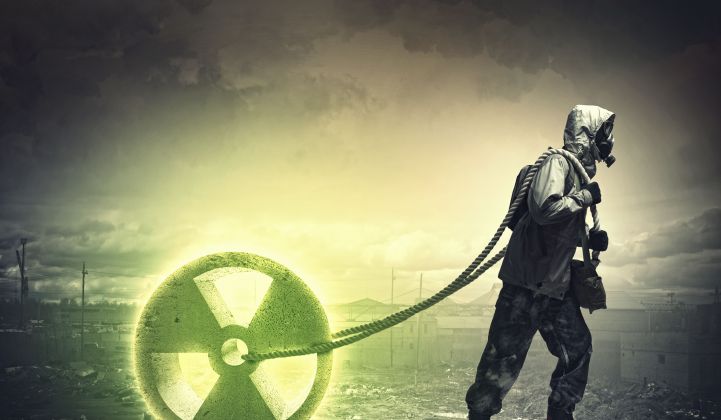Could thorium be the faltering nuclear industry’s salvation -- or is it a mirage?
“We should be trying our best to develop the use of thorium,” former U.N. weapons inspector Hans Blix recently told BBC News. “I am told that thorium will be safer in reactors -- and it is almost impossible to make a bomb out of thorium.”
Thorium is up to 200 times more energy-dense than uranium and as common as lead. It could be a safer, cheaper nuclear fuel, GTM reported shortly after the 2011 Fukushima disaster: “China, India, Japan, France, Russia and the U.S. are all currently developing thorium-based reactors.”
Yet thorium-based nuclear power is still a hypothesis. As Blix noted, besides the technical obstacles, there is a multi-billion-dollar uranium-based nuclear industry “backed by vested interests” that could be hampering development efforts.
“Uranium, which is much better for making bombs, took over the stage” during World War II, according to Richard Martin, SuperFuel author and thorium advocate, on NPR’s Science Friday last year. Thorium was “pushed aside.”
It could be coming back. India, with the world’s biggest thorium resource, is committed to a program using “thorium compounds as breeder fuel to produce more uranium.” It plans to get “30 percent of its electricity from thorium reactors by 2050,” according to the November Economist.
China is developing “a next-generation reactor which its supporters say will enable thorium to be used much more safely than uranium,” BBC News said. And Norway’s Thor Energy is developing thorium technology through an “evolutionary approach” that will use thorium “in existing reactors together with uranium or plutonium.”

TerraPower, backed by Microsoft billionaires Bill Gates and Nathan Myhrvold, is a uranium-based small modular reactor (SMR) technology that reuses stockpiled nuclear waste. The New York Times recently called it “a very long-term bet.”
Thorium technologies fit the nuclear industry’s move toward SMRs. Flibe Energy’s modular liquid-fluoride thorium reactor (LFTR) and “known thorium reserves” could supply “advanced society for many thousands of years,” according to a claim made on the the company's fact sheet.
The external nuclear chain reaction of LFTRs also reuses stockpiled nuclear waste and safely eliminates the need for containment vessels because it shuts down automatically if there is a disruption. Thorium is cheaper and more efficient than uranium, and LFTR modular reactors could be mass-produced cost-effectively, use less water, and provide waste heat and marketable byproducts.
Nobel laureate and former CERN Director Carlo Rubbia leads advocacy for an alternative accelerator-driven system (ADS) thorium technology that would give thorium "absolute pre-eminence" over other fuels, Rubbia said recently. Norwegian nuclear industry player Aker Solutions purchased Rubbia’s patents earlier this year and is investing $1.8 billion in their development.
According to Jefferson Laboratory Associate Director Andrew Hutton, ADS could “transform the landscape of the waste-disposal and storage problem.” It is minimally radioactive, shuts down automatically, and offers “proliferation resistance.”
However, critics have cited some concerns about thorium. It does not resolve nuclear power’s proliferation and waste issues, Institute for Energy and Environmental Research President Dr. Arjun Makhijani responded to Martin on the NPR program last year. Pure uranium-233 can be derived from the molten salt coming out of thorium reactors “which is easier to make bombs with than plutonium.” And the waste, Makhijani added, contains carcinogenic radioactive materials.

Deriving U-233, Martin said, is “virtually impossible, even for a sophisticated nuclear power lab, much less for a rogue nation or terrorist group.” Thorium reactors do create waste, he acknowledged. But they use stockpiled waste as a starter, their waste is “tenths of a percent of the comparable volume from a conventional reactor,” and its half-life is “a few hundred years as opposed to tens of thousands of years.”
Dr. Alvin Weinberg, the “guru” of thorium nuclear technology, called it a “Faustian bargain” and said it was “a great energy source, but you've got to worry about proliferation and waste,” Makhijani replied.
“OK, you have concerns about thorium-based nuclear power,” Martin replied. “But what is the answer? Renewables are not going to solve our problem in the time scales that we need it, in the next 30 to 50 years.” The choice is between “an innovative form of nuclear power” and “a three-degree-Celsius rise in global temperatures over the next 50 years.”
“My reactor is free. It's in the sky, 93 million miles away. You can store its energy in molten salt. It is being done today. You can generate electricity for 24 hours a day,” Makhijani answered.
Even with extensive investment in thorium technology, he said, it would take ten years to build the infrastructure and ten more to put regulation in place. “I did an honest, unbiased look, not thinking we could do renewable energy. And I found out that my hunch was wrong: We can do 100 percent renewable energy.”
Thorium will not happen in the United States “because of the licensing issues,” Martin agreed. It is happening in China, India, and Western Europe. “The thorium revival is inevitable. The question is whether the United States is going to be a follower or a leader.”
“Let them raise venture capital and do it,” said Mark Cooper, Vermont Law School Institute for Energy and the Environment nuclear economics researcher. “[There are] low-carbon and no-carbon technologies whose costs have been coming down and they can keep the lights on. In 25 years, [there will likely be] a whole range of cost-effective ways to keep the lights on that evolve from the current set of technologies.”



